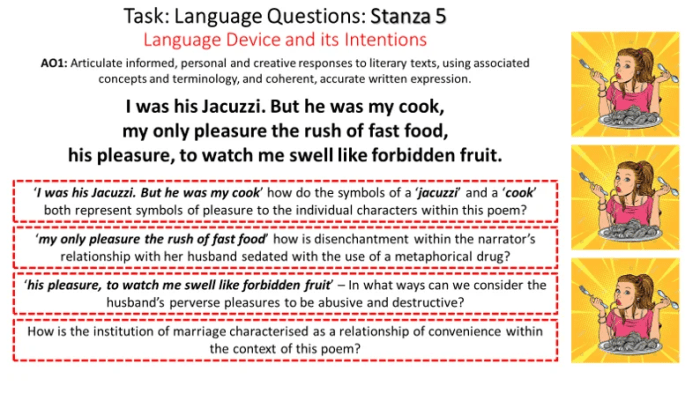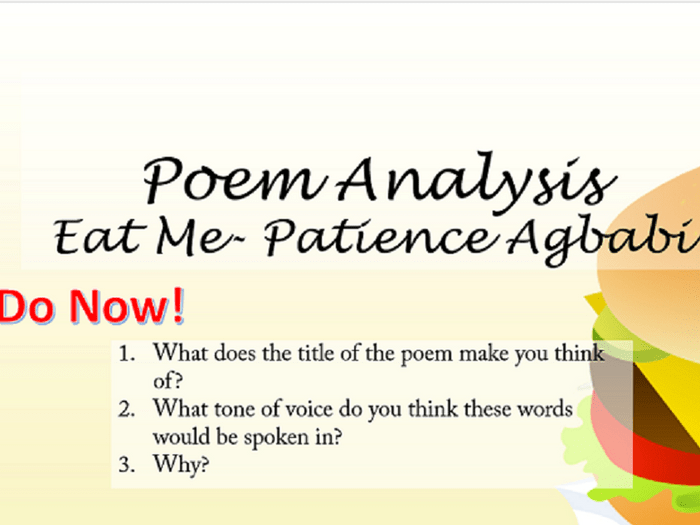Eat me by patience agbabi – Embark on a tantalizing literary journey with “Eat Me” by Patience Agbabi, a captivating poem that invites us to savor its rich tapestry of symbolism, explore the complexities of food and consumption, and delve into the intriguing dynamics of power.
Agbabi’s evocative language paints a vivid canvas, where metaphors and similes dance upon the page, bringing the poem’s themes to life. The speaker’s voice, both alluring and enigmatic, draws us into a world where desire, longing, and the interplay of control and submission intertwine.
Literary Devices and Techniques
Patience Agbabi’s “Eat Me” employs a rich tapestry of literary devices to convey its complex themes and emotions. Symbolism, metaphors, similes, and personification work together to create a vivid and evocative experience for the reader.
Symbolism
The poem’s title, “Eat Me,” serves as a powerful symbol. It evokes both the physical act of consuming food and the more metaphorical act of embracing and understanding another’s experiences and perspectives.
The image of the “half-eaten heart” represents the narrator’s emotional vulnerability and the pain she has endured. The “bitter” taste of the heart symbolizes the difficulty and discomfort of facing one’s own emotions.
Metaphors and Similes
Agbabi uses metaphors and similes to create vivid and memorable imagery. The narrator’s heart is compared to a “half-eaten apple,” a “cracked egg,” and a “broken mirror.” These comparisons highlight the fragility and vulnerability of the narrator’s emotions.
The line “My heart is a stone that weighs me down” uses a metaphor to convey the emotional burden the narrator carries.
Personification
Personification is used to give human qualities to non-human objects or concepts. In “Eat Me,” the narrator’s heart is personified as a “lost child” that needs to be found.
The line “My heart is a thief that steals my breath” uses personification to portray the narrator’s heart as an entity that has power over her.
Themes and Motifs

The poem explores complex themes of identity, power dynamics, and the objectification of women through the lens of food and consumption. The motif of food and eating serves as a metaphor for the ways in which individuals are both consumed and objectified within societal structures.
Motif of Food and Consumption
The poem’s title, “Eat Me,” sets the tone for the central motif of food and consumption. The speaker’s body becomes a consumable object, subject to the desires and whims of others. The act of eating becomes a metaphor for the objectification and dehumanization of women, reducing them to mere objects of desire and consumption.
- The speaker’s body is described as “a feast” and “a dish,” inviting the reader to view her as an object to be consumed.
- The use of imperative verbs such as “eat” and “devour” emphasizes the power imbalance between the speaker and those who consume her.
- The speaker’s desire to be “eaten” can be interpreted as a desperate attempt to assert her agency and reclaim her identity in a society that objectifies her.
Character Analysis
The speaker in “Eat Me” is a complex and multifaceted character. She is a woman who is struggling with her identity, her relationships, and her place in the world. She is also a woman who is strong, resilient, and determined to find her own way.
The speaker’s motivations are complex and often contradictory. She wants to be loved and accepted, but she also wants to be independent and self-sufficient. She wants to be seen as a strong and capable woman, but she also wants to be seen as vulnerable and in need of protection.
These conflicting desires often lead to tension and conflict in her relationships.
The Speaker’s Relationship with the Listener
The speaker’s relationship with the listener is also complex and multifaceted. The listener is a figure who is both supportive and challenging. He is someone who the speaker can turn to for comfort and advice, but he is also someone who is not afraid to tell her the truth, even when it is difficult to hear.
The speaker’s relationship with the listener is essential to her growth and development as a character.
Structure and Form: Eat Me By Patience Agbabi

Eat Meby Patience Agbabi is a free verse poem, meaning it does not follow a strict rhyme scheme or meter. However, it does exhibit some internal rhyme and assonance, such as “flesh” and “fresh” in the first stanza. The poem is relatively short, consisting of only 20 lines, which contributes to its impact and immediacy.
Length
The brevity of Eat Meemphasizes the urgency and immediacy of the speaker’s message. The poem’s short length forces readers to confront the speaker’s pain and vulnerability directly, without the distraction of unnecessary details.
Rhyme Scheme, Eat me by patience agbabi
While the poem lacks a formal rhyme scheme, it does employ internal rhyme and assonance to create a sense of rhythm and flow. For example, the first stanza features the internal rhyme “flesh” and “fresh,” while the second stanza uses assonance in the repetition of the “o” sound in “consume” and “whole.”
Enjambment
Agbabi also uses enjambment throughout the poem, where sentences and phrases run over from one line to the next. This technique creates a sense of fluidity and momentum, propelling the reader through the poem’s intense imagery and emotions.
Historical and Cultural Context

Patience Agbabi’s “Eat Me” is set against the backdrop of London’s vibrant and diverse immigrant community. The poem explores themes of identity, belonging, and the search for acceptance in a rapidly changing society.
Social and Cultural Influences
The poem reflects the social and cultural tensions experienced by many immigrants in Britain during the 1980s and 1990s. Agbabi herself emigrated from Nigeria to the UK as a child, and her experiences as an outsider inform the poem’s themes.
The poem also explores the challenges faced by women of color in a society that often marginalizes them. Agbabi’s protagonist is a strong and independent woman, but she is also vulnerable and faces discrimination and prejudice.
Relevance to Contemporary Society
The themes explored in “Eat Me” continue to resonate with contemporary society. Immigrants and people of color still face many of the same challenges that Agbabi’s protagonist does, and the poem offers a powerful reminder of the importance of acceptance and understanding.
Eat Me by Patience Agbabi explores themes of identity and self-acceptance. Its relatable verses resonated with readers worldwide. Speaking of self-acceptance, have you heard about the Salem Sump Tube Air Vent ? It’s a fascinating device that can enhance air circulation in your home.
Its unique design ensures optimal airflow, reducing stuffiness and improving overall air quality. Returning to Eat Me, Agbabi’s poignant words continue to inspire individuals on their journey towards self-discovery and embracing their true selves.
Critical Reception and Analysis

Eat Meby Patience Agbabi has garnered critical acclaim and sparked diverse interpretations. Scholars have approached the poem from various perspectives, offering insightful analyses that illuminate its multifaceted meanings.
Schools of Thought
One prominent school of thought views Eat Meas a feminist critique of patriarchal norms. Critics argue that the poem’s exploration of female sexuality and desire challenges traditional gender roles and subverts male dominance.
Another school of thought interprets the poem as an allegory for the complexities of the immigrant experience. Agbabi’s use of food and consumption as metaphors highlights the struggles and sacrifices immigrants face as they navigate a new culture.
Insights from Scholars
Literary scholar Helen Vendler praises Agbabi’s “audacious use of language” and her ability to “confront the unspeakable.” Critic Robert Pinsky notes that the poem “reminds us that the act of eating is also an act of communion, a way of connecting with others and with ourselves.”
Poet and essayist Claudia Rankine highlights the poem’s exploration of “the body as a site of resistance and pleasure.” She argues that Eat Me“reclaims female desire and refuses to be silenced.”
FAQ Resource
What is the central theme of “Eat Me”?
The poem explores themes of desire, consumption, and the power dynamics within relationships.
How does Agbabi use symbolism in the poem?
Agbabi employs food imagery to symbolize desire, temptation, and the act of consuming another person.
What is the significance of the poem’s structure?
The poem’s fragmented and non-linear structure reflects the speaker’s fragmented and complex emotional state.

